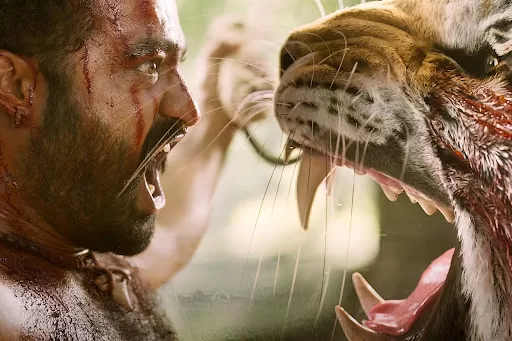Hollywood, the global hub of the film industry, generates annual revenues exceeding $43 billion. However, some argue that the golden age of American cinema has long passed, with the most exceptional films being produced in the 1980s and 1990s.
Nowadays, there is a prevailing trend of reboots, sequels, and grand-scale superhero spectacles, which are valued more highly than original and captivating storytelling. While Bollywood may not wield the same level of global influence as Hollywood, the Indian film industry is making remarkable strides forward. Can it ever bridge the gap and catch up to the colossal entity from which it derived its name?

With Bollywood smash hits like RRR, there’s unquestionably a handful of debatable factors that could hint at a bridged gap between the Asian film scene and world-renowned Hollywood.
What is RRR & Why’s Everyone Talking About It?
In simple terms, this film is a breathtaking spectacle of action that utilizes CGI to defy the laws of physics and reality. Bodies soar through the air, and explosions light up the sky, leaving viewers in awe. If this piques your interest, set aside three hours and hit the “play” button before continuing this article.
For those who want to taste what’s to come, consider jumping to the thirty-minute mark. Here, you’ll witness a pivotal scene where the film’s two protagonists, Alluri Sitarama Raju (played by Ram Charan) and Komaram Bheem (played by N. T. Rama Rao Jr.), inspired by real-life Indian revolutionaries but with creative liberties taken, meet and exchange a silent plan to rescue a child from a fiery demise caused by a train crash into a river. Their plan involves a motorcycle, a horse, a rope, a flag, daring leaps, and impeccable timing. The opening credits finally appear as they clasp hands, expressing their newfound friendship.
We don’t want to provide too many spoilers, but to further understand the film’s significance, “RRR” has garnered significant acclaim since its release, earning recognition as one of the top films by numerous American publications, as well as securing prestigious accolades like the Golden Globe and Critics Choice Awards.
Rajamouli, the film’s director, has enjoyed a warm reception at packed screenings in Los Angeles. In addition, he was invited as a guest on the “Late Night with Seth Meyers” show following his win for Best Director at the New York Film Critics Circle Awards. The National Board of Review has also named “RRR” one of the ten best films of 2022, while it remains in contention for the long list of nominations from BAFTA. Rajamouli has further delighted fans by sharing photographs alongside esteemed filmmakers Steven Spielberg and James Cameron.
Bollywood: Exploring Alternative Media
To compete with Hollywood in terms of revenue, Bollywood may consider adopting the American film industry’s expansion strategy, which often involves branching out into other media. The film franchises of the 2010s marked a significant shift as they extended into the realm of gaming across various platforms.
For instance, Jurassic World, released in 2015, is a prime example. It is the sixth highest-grossing film of all time, generating over $1.6 billion in global revenue. The movie’s success was further amplified by its online slot game counterpart and mobile games like Jurassic World Alive. Those wanting to discover online casino games in India can also be exposed to a film franchise’s branding simultaneously. These gaming experiences attracted a new audience, potentially introducing them to the film and sparking an unexpected admiration.
The Bollywood industry can benefit from entering such initiatives as the online casino sector and expanding its presence in other branches of the gaming industry, such as console and mobile. Additionally, gaining visibility on popular streaming platforms like Netflix and Amazon Prime has already enhanced the Indian film industry’s exposure.
Bollywood: Overcoming a lack of scope
Although not on the same scale as Hollywood globally, Bollywood boasts a remarkably large audience that can rival the American film industry. In 2001, it was discovered that Bollywood surpassed Hollywood in terms of ticket sales, with the Indian film industry selling 3.6 billion tickets compared to America’s 2.6 billion.
The main issue formerly faced by the Indian film industry is its limited scope and frequent blending of genres in what is known as the “masala film.” A prime example of this is Manmohan Desai’s Amar Akbar Anthony. While such films are greatly adored in India, they may appear less appealing to international moviegoers who often seek out and prefer specific genres.
A common critique of Indian cinema is its failure to offer a diverse range of film types, but this is where films like RRR have started to bridge the gap. Additionally, it doesn’t have to be a battle between Bollywood and Hollywood, as collaborations between the two would unquestionably deliver a significantly higher production value for a global audience, and we’ve witnessed this in the past with films like Slumdog Millionaire and Life of Pi.
